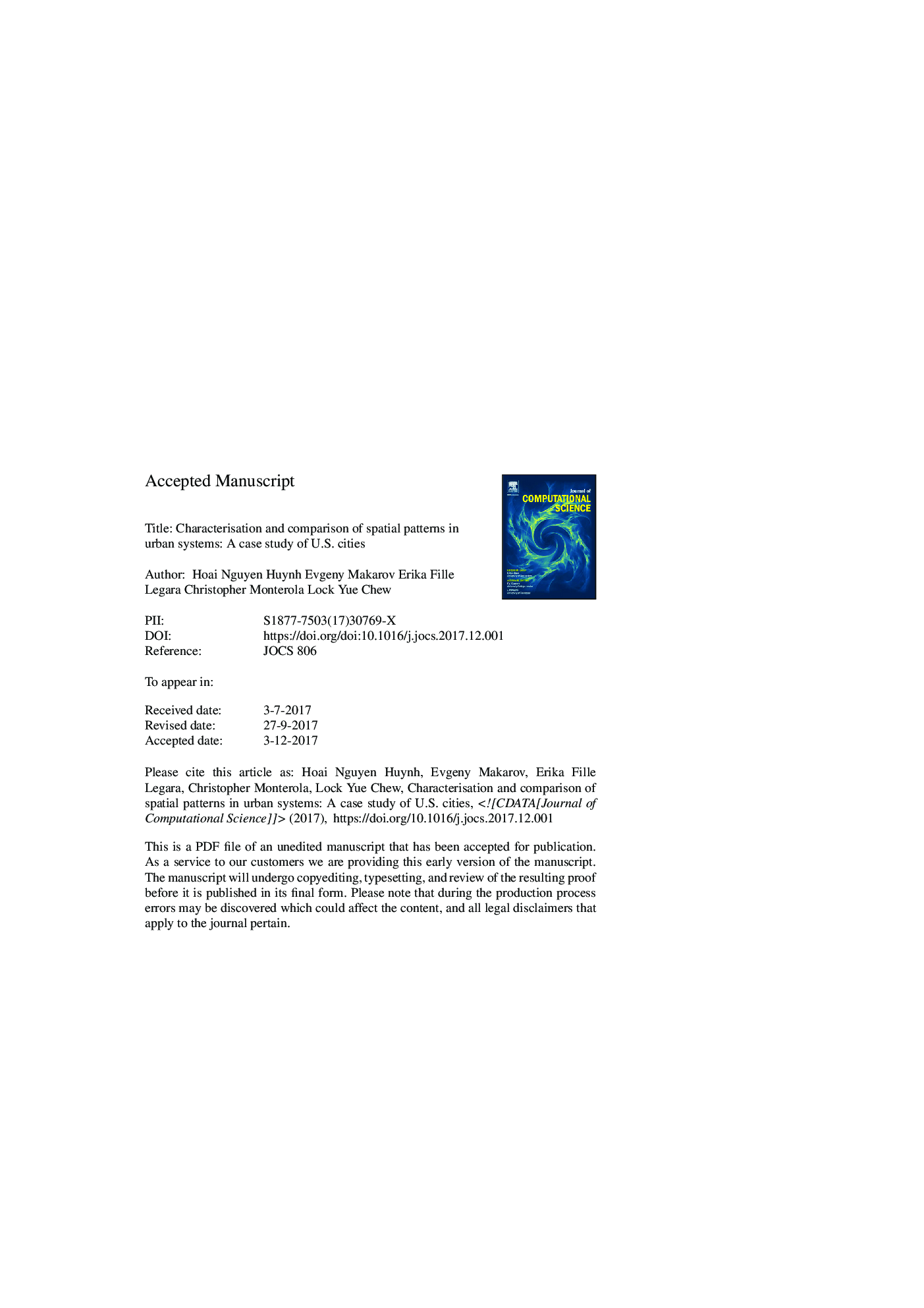| کد مقاله | کد نشریه | سال انتشار | مقاله انگلیسی | نسخه تمام متن |
|---|---|---|---|---|
| 6874416 | 1441161 | 2018 | 35 صفحه PDF | دانلود رایگان |
عنوان انگلیسی مقاله ISI
Characterisation and comparison of spatial patterns in urban systems: A case study of U.S. cities
ترجمه فارسی عنوان
ویژگی و مقایسه الگوهای فضایی در سیستم های شهری: مطالعه موردی شهرهای ایالات متحده
دانلود مقاله + سفارش ترجمه
دانلود مقاله ISI انگلیسی
رایگان برای ایرانیان
کلمات کلیدی
مورفولوژی شهری، الگو نقطه ی فضایی، شعاع بافر، خوشه، پرکولاسیون، هندسه،
ترجمه چکیده
درک مورفولوژی سیستم شهری یک گام مهمی در جهت بروز فرایندهای دینامیکی رشد و توسعه است که می تواند از طریق مطالعه سیستم حمل و نقل آن به دست آید. بدون شک، حمل و نقل پایه و اساس هر سیستم شهری است، و این یک جزء حیاتی است که قابلیت های متنوع اجتماعی و اقتصادی در یک شهر را فراهم می کند. در این مقاله، با تجزیه و تحلیل توزیع نقاط حمل و نقل عمومی، با استفاده از یک روش مبتنی بر خوشه های نفوذ شناخته شده در فیزیک آماری، الگوی فضایی 53 شهر در ایالات متحده مورد مطالعه قرار گرفت. تجزیه و تحلیل ما نشان داد که توزیع فضایی مختلف نقاط به طور کلی می تواند به چهار گروه با ویژگی های متمایز طبقه بندی شده: خوشه ای، پراکنده و یا به طور منظم توزیع شده است. از بازبینی بصری، ما مشاهده کردیم که شهرهایی که الگوهای منظم توزیع شده دارند، مرکز ظاهری ندارند. این در مقایسه با دو نوع دیگر است که در آن ساختار تک هسته ای (یا ساختار ستاره ای) می تواند به وضوح مشاهده شود. به طور خاص، نتایج ما شواهد کمی در مورد وجود دو اشکال مختلف سیستم شهری ارائه می دهد: به خوبی برنامه ریزی شده و ارگانیک رشد کرده است. علاوه بر این، ما همچنین در توزیع فضایی یکی دیگر از امکانات مهم شهری مورد بررسی قرار گرفتیم و دریافتیم که خواص جهانی صرف نظر از نوع الگوی فضایی شهر است. این نتیجه مستلزم مهم است: دینامیک شهری را نمی توان در سطح محلی کنترل کرد، هرچند مقررات در مقیاس کل سیستم شهری محاسبه شده است. علاوه بر این، روابط جالب میان توزیع امکانات رفاهی درون شهر و الگوی فضایی آن در این مقاله مشخص شده است.
موضوعات مرتبط
مهندسی و علوم پایه
مهندسی کامپیوتر
نظریه محاسباتی و ریاضیات
چکیده انگلیسی
Understanding the morphology of an urban system is an important step towards unveiling the dynamical processes of its growth and development, which can be achieved through a study of its transportation system. Without doubt, transportation is the foundation of every urban system, and it is a crucial component that enables diverse social and economic functions within a city. In this paper, we studied the spatial pattern of 53 cities in the U.S. by analysing its distribution of public transport points, using a method based upon clusters of percolation known in statistical physics. Our analysis revealed that different spatial distributions of points can generally be classified into four groups with distinctive features: clustered, dispersed, or regularly distributed. From visual inspection, we observed that cities with regularly distributed patterns do not have apparent centre. This is in contrast to the other two types where monocentric (or star-node structure) can be clearly observed. In particular, our results provide quantitative evidence on the existence of two different forms of urban system: well-planned and organically grown. In addition, we had also investigated into the spatial distribution of another important urban entity-the amenities, and found that it possessed universal properties regardless of the city's spatial pattern type. This result has an important implication: urban dynamics cannot be controlled at the local scale even though regulation has been meted out at the scale of the entire urban system. Furthermore, interesting relationships between the distribution of amenities within the city and its spatial pattern are detailed in the paper.
ناشر
Database: Elsevier - ScienceDirect (ساینس دایرکت)
Journal: Journal of Computational Science - Volume 24, January 2018, Pages 34-43
Journal: Journal of Computational Science - Volume 24, January 2018, Pages 34-43
نویسندگان
Hoai Nguyen Huynh, Evgeny Makarov, Erika Fille Legara, Christopher Monterola, Lock Yue Chew,
